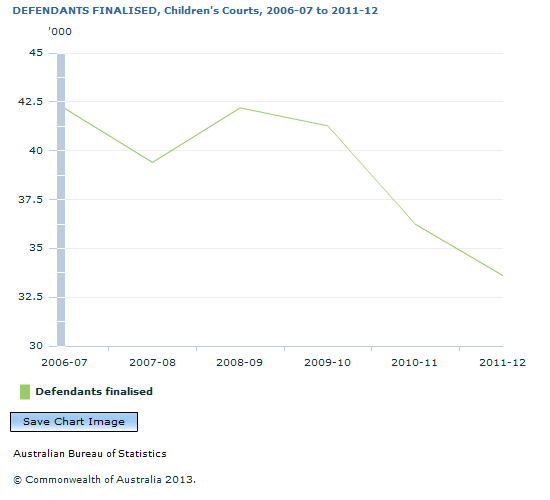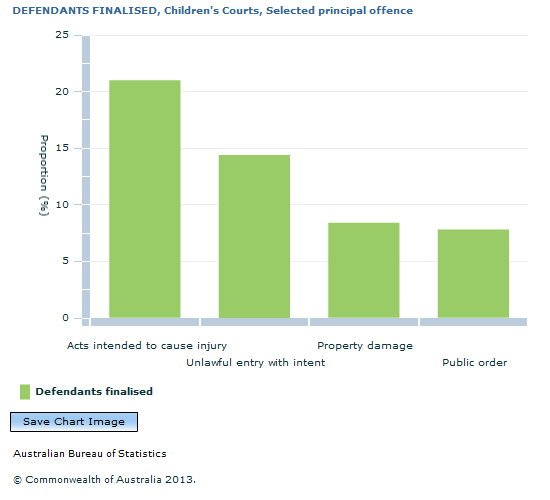4513.0 - Criminal Courts, Australia, 2011-12  Quality Declaration
Quality Declaration
ARCHIVED ISSUE Released at 11:30 AM (CANBERRA TIME) 14/02/2013
Page tools:
 Print Page Print Page
 Print All Print All
| ||||
DEFENDANTS FINALISED Defendants can have their charges finalised via a range of methods (see Appendix 2). The main categories of finalisation are: adjudicated finalisations, where there is a guilty plea or the court has made a finding as to the guilt or otherwise of the defendant; transfer between court levels; withdrawal by the prosecution; and other methods such as the defendant being deceased or considered unfit to plead. In 2011-12, the number of defendants finalised (33,604) was the lowest since the Children's Courts collection began in 2006-07. Six jurisdictions had decreases in the numbers of defendants finalised in the Children's Courts in 2011-12: Tasmania (24%), Western Australia (20%), the Australian Capital Territory (17%), South Australia (7%), Queensland (6%) and Victoria (4%). The remaining two states and territories had increases: the Northern Territory (17%) and New South Wales (1%).  Source(s): Criminal Courts, Australia Sex In 2011-12, 79% (26,485) of defendants heard in the Children's Courts were males, while females accounted for 21% (7,106). The number of male defendants adjudicated decreased from 28,698 in 2010-11 (a reduction of 8%), while females defendants decreased from 7,517 in 2010-11 (a reduction of 6%).  Source(s): Criminal Courts, Australia The ratio of males and females was similar across the states and territories. Queensland had the lowest proportion of males (76%) and the Australian Capital Territory had the highest proportion of males (89%). The proportion of males proven guilty and the proportion of females proven guilty was very similar (79% compared to 78%). Both males and females had the same proportion of defendants acquitted (4%). Age The largest proportion of defendants finalised in the Children's Courts were aged 17 years at the time of finalisation (25% or 8,278 defendants), followed by those aged 16 years (24% or 8,073 defendants). Those aged 10 to 12 years comprised 3% (1,001). The largest proportion of males finalised were aged 17 years (26%), followed by those aged 16 years (24%). The age profile for females was younger with the largest proportion of females finalised aged 16 years (25%) followed by those aged 17 years (21%). Principal offence In 2011-12, those finalised with a principal offence of acts intended to cause injury formed the largest proportion of defendants (21%) in the Children's Courts. In 2009-10 and 2010-11, acts intended to cause injury was the second largest offence category and theft was the largest. In 2011-12, acts intended to cause injury was followed by: theft (20%), unlawful entry with intent (14%), property damage (8%) and public order offences (8%). Combined, these principal offences accounted for almost three-quarters (72%) of defendants finalised in the Children's Courts in 2011-12.  Source(s): Criminal Courts, Australia Sex and age and principal offence The most common offences in the Children's Courts were the same for male defendants and female defendants in 2011-12. Acts intended to cause injury represented 19% of male finalisations and 29% of female finalisations, while theft represented 18% of male finalisations and 27% of female finalisations. For acts intended to cause injury, the age group with the highest number of defendants was 17 years for males and 16 years for females. Theft was the most common offence for younger males finalised in the Children's Courts. It accounted for 21% of finalisations for defendants aged 10 to 12 years, 25% of 13 year olds, 22% of 14 year olds and 20% of 15 year olds. For females, theft was most common for 13 year olds (29%), 15 year olds (31%), 18 year olds (28%) and defendants aged 19 years and older (27%).
|
||||
